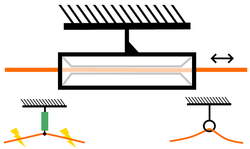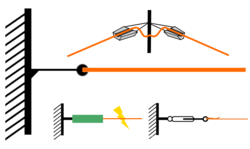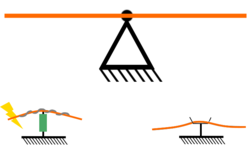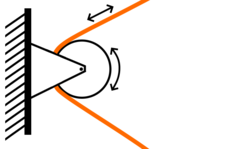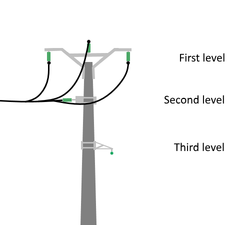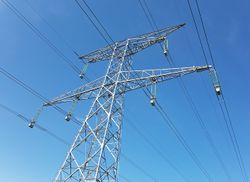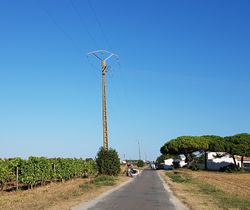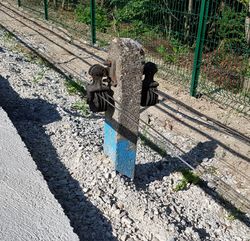Proposal:Lines attachments
| The Feature Page for this approved proposal is located at Key:line_attachment |
| Lines_attachments | |
|---|---|
| Proposal status: | Approved (active) |
| Proposed by: | Fanfouer |
| Tagging: | line_attachment=* |
| Applies to: | |
| Definition: | Consistently defining how a power, telecom or even washing line is attached to its supports |
| Statistics: |
|
| Draft started: | 2018-06-27 |
| RFC start: | 2018-07-26 |
| Vote start: | 2019-07-14 |
| Vote end: | 2019-07-28 |
Proposal & rationale
Line attachment is about how wires, cables or conductors are bound to their supports. Depending of distances, environment and climate conditions, engineers have to choose between suspension or anchorage.
Additional situations can be found on lines extremities or branches.
Here are some definitions in use in power domain, useful to define some terms and values of this proposal
- Suspension set (466-12-03) : An assembly of strain link and a clamp to support a line/cable at the assembly lower end. Suspension supports aren't designed to preserve the line tension but the line isn't expected to move due to clamps. Insulators are used as link in case of bare power conductors.
- Tension set (466-12-04) : An assembly of strain link and an anchor clamp to maintain the mechanical tension in a line/cable. Insulators are used as link in case of bare power conductors.
- Anchor clamp (466-11-10) : A device fitting a line/cable to a strain link as to maintain the mechanical tension in the line. The clamp is at the live end of insulators in case of bare power conductors.
- Pulley : A support built with a wheel intended to redirect a longitudinal effort along a movable wire. Such supports actually hold the cable but allow it to move instead of many others. They are used to change the direction of the cable while it is tensed to fit in the wheel groove.
Despite the tension set definition upside, it is chosen to only deal with anchors here since mappers may be more inspired by this term and the according tagging value. (Mechanical) tension is too near of electrical tension and power lines mappers may be to easily confused.
OSM only describes power lines attachments at the moment with multi-purpose key tower:type=*. The same key is used to make the difference between a castle tower and a telecommunication tower based on their structure and material. This is inconsistent and less usable.
This information is useful for telecom wires too (but also and mostly for washing lines mapping :) ) and doesn't involve insulators. Then it's more appropriate to deal with standard attachment and share those concepts instead of proper insulators. Additional keys could be defined to complete the tagging and give more details about insulators sets/chains.
It is proposed to use a new line_attachment=* key to free tower:type=* and pole:type=* from defining how lines connect to supports. This would allows us to keep tower:type=* to define towers shape and to extend line attachment to other kind of supports like poles, portals or even terminal anchors. Current available tagging describes attachments globally without any specific terminology regarding power nor telecom. This proposal is mainly usable for utilities networks and this work could easily be extended with more specific terms or be used for other fields of knowledge also with further proposals.
Similar problem has been discussed in a 2015 proposal about power supports refinement.
Concrete benefits
- Share equivalent concepts between many fields of knowledge (power, telco, cable transport / towers, poles, masts, terminal and portals) and provide to mappers a common set of terms matching what they will actually see on the field.
- Ability to describe more precisely the structure of a tower or a pole without get stuck with what and how it is supported.
- Split according values to a dedicated key and free tower:type=*, pole:type=* with less related values. Prevent the definition of same kind values to :type keys.
Tagging
Values are similar to current tower:type=* associated with power=tower
Illustrations are inspired from ISO 3952-1 mechanical documentation.
| Picture | Key/Value | Description |
|---|---|---|
| line_attachment=suspension | A support which vertically hold an underside continuous line using suspension attachment. A suspension has no moving part and usually prevent line to move longitudinally although this is not mandatory. This is the default type and doesn't need to be tagged. However it may be useful to tag a suspension support if it is used as an angle tower (an anchor tower would normally be expected here) | |
| line_attachment=anchor | A support where line sections are hold with strain tension sets. Such supports are normally built stronger than suspension towers as they are supposed to maintain the mechanical tension in the line through tension sets and anchor clamps. Often used as angle tower when the line changes direction. Lines often terminate on anchors even if it's not mandatory. | |
| line_attachment=pin | Pin is the opposite of suspension. Vertical attachment sets are also used but to support lines from under. Situation on which lines terminate on pin support isn't known currently. | |
| line_attachment=pulley | A pulley support is different from a suspension or anchor attachment. With an appropriate mechanical tension, the line/cable is hold by a vertical accessory and maintained at a proper distance of the support without any clamp to fit them. The cable can move and the support is designed to follow it with a moving part (mandatory). The usual groove wheel for such pulleys can be replaced by an appropriate insulator in case of bare power conductors. A pulley on which the line is terminating is an actual anchor and shouldn't be confused with this value. |
Complex configurations
As some supports may have a complex arrangement of line attachments, a matrix tagging may allow us to give all details about this.
We could use pipes and parenthesies as follow to describe such cases, according to picture beside:
line_attachment=(suspension|pin|suspension)|(anchor)|(suspension)
The pipe | separates sections and levels, i.e the arrengement of attached lines on the support at a given level and different level as well.
Then the first level is accordingly suspension|pin|suspension.
The second level is simpler anchor
The third level is also simple suspension
This is equivalent to what was chosen to tag highways/railway lanes and described in according article.
Values would be given from left to right / top to down of the pole in the direction of the drawn way passing by the supporting node.
Chart below summarise many possibilities:
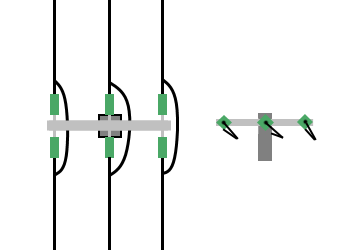
|
Anchor pole power=pole line_attachment=anchor |
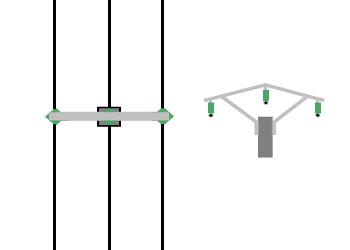
|
Suspension pole power=pole line_attachment=suspension |
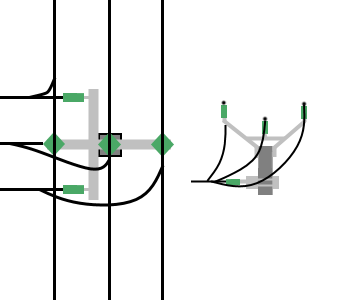
|
Branch pole power=pole line_attachment=(pin)|(anchor) pole:type=branch |
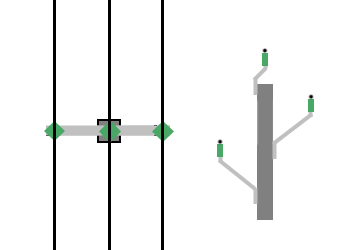
|
Pin pole power=pole line_attachment=pin |
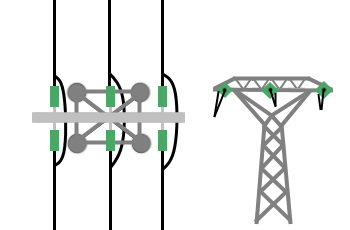
|
Anchor tower power=tower line_attachment=anchor |
Edition management
Affected pages
- Create line_attachment=* and add proposed values.
- Edit tower:type=* and remove anchor and suspension related to power=tower association
- Edit power=terminal and make it implies line_attachment=anchor.
- Edit power=pole and change pole:type according values for line_attachment=*.
- Edit pole:type=* and warns about possible mistakes with line_attachment=*
Values to be replaced
| Obsolete tag | Usage volumetry | Used for ? | New tag(s) to use |
|---|---|---|---|
| tower:type=suspension | 24 372 on 2019-06-23 | The line is supported with vertical insulators | line_attachment=suspension |
| tower:type=anchor | 12 591 on 2019-06-23 | Section of wires or conductors stops on support on strain mechanical link | line_attachment=anchor |
| pole:type=suspension | 1 969 on 2019-06-23 | The line is supported with vertical insulators | line_attachment=suspension |
| pole:type=anchor | 1 781 on 2019-06-23 | Section of wires or conductors stops on support on strain mechanical link | line_attachment=anchor |
These are the ones which don't need a special value of tower:type=*.
A whole total of 41 000 objects have to be edited, which doesn't sound so important regarding the 10 millions power towers in OSM.
Values to be added
| Current tag | Usage volumetry | Used for ? | New tag(s) to add |
|---|---|---|---|
| tower:type=branch | 1 608 on 2018-06-26 | A side branch connect to the main line on this support with specific clamps | line_attachment=anchor |
| tower:type=termination | 4 476 on 2018-06-26 | The line stops on the support with strain clamp. Nevertheless attachment is anchor | line_attachment=anchor |
| tower:type=crossing | 1 125 on 2018-06-26 | A particular support higher than others intended to make a line cross an obstacle. Nevertheless attachment is anchor or suspension | line_attachment=anchor or line_attachment=suspension |
| pole:type=branch | 643 on 2018-08-09 | A side branch on a power pole supporting another power line | appropriate line_attachment=* |
Examples
Power
| Photo | Location | Tagging | Note |
|---|---|---|---|
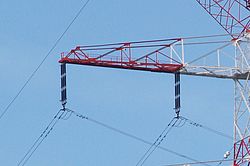 |
Germany | Although insulators are vertical here, it's an actual anchor support. Look closely to conductors vs insulators link : conductors are cut and clamped right under the insulation chain. | |
| Germany | Traditional power line anchorage clamping with strain insulators mechanically holding each conductor | ||
| France | Power tower supporting a 400kV overhead power line with suspension attachement | ||
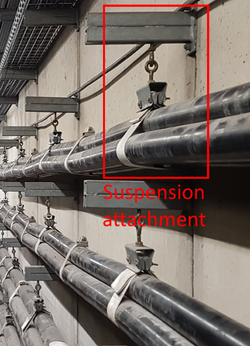 |
Austria | Here power cables are suspended without insulators on fixed support mounted on concrete walls directly. | |
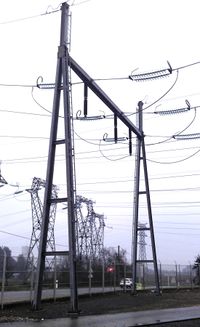 |
France | A high voltage line anchorage on a metallic power portal | |
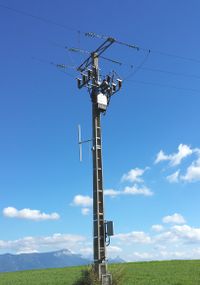 |
France |
power=pole
|
20 kV power line anchorage on a concrete pole supporting a power switch |
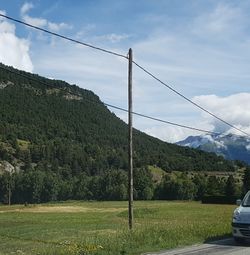 |
France | A suspension power pole supporting a power cable along a road | |
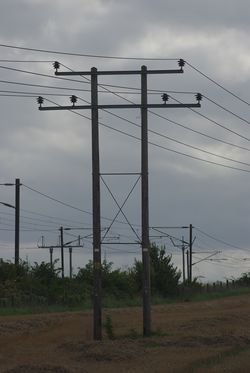 |
England | A double level h-frame power pole supports a 2-circuits power line from under with pin insulators |
Telecoms
| Photo | Location | Tagging | Note |
|---|---|---|---|
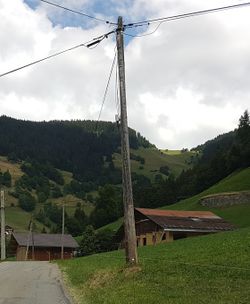 |
France |
telecom=pole (Theoretically)
|
A telecom pole made of wood where households lines are anchored on. |
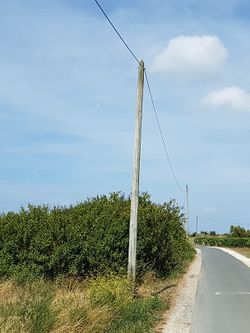 |
France |
telecom=pole (Theoretically)
|
A telecom pole made of wood where a cable is suspended along a road |
Multi-utilities
| Photo | Location | Tagging | Note |
|---|---|---|---|
| France |
power=pole
|
A pole can host several different configuration like this one. Suffixes help to give all details about line supported by the pole. |
Misc
| Photo | Location | Tagging | Note3 |
|---|---|---|---|
| France | Cables are designed to move along supporting pulleys (you can see the lubricant around them) to remotely actuate railway switches near of a station. | ||
| Germany | Wood post insulators supports live wires of electric fences. Despite the cable can move through the insulator, this is not a pulley but a suspension since there is no moving part in the support and it is not designed to follow line movement like an actual pulley does. | ||
| Lack of free illustration See [1] |
-- |
Unknown tagging for such a support, power=pole sounds overkill for electric fences.
|
Wood post insulators supports live wires of electric fences. This support is designed to allow movement of the live wire. This is an actual pulley and not a suspension one. |
| Germany | Chains are hold by pulleys to redirect effort orthogonally |
See also
Voting
Voting on this proposal has been closed.
It was approved unanimously with 23 votes for.
 I approve this proposal. --Nocarto (talk) 11:33, 30 July 2019 (UTC)
I approve this proposal. --Nocarto (talk) 11:33, 30 July 2019 (UTC) I approve this proposal. --EneaSuper (talk) 15:37, 22 July 2019 (UTC)
I approve this proposal. --EneaSuper (talk) 15:37, 22 July 2019 (UTC) I approve this proposal. --LeifRasmussen (talk) 14:29, 14 July 2019 (UTC)
I approve this proposal. --LeifRasmussen (talk) 14:29, 14 July 2019 (UTC) I approve this proposal. --Don-vip (talk) 14:36, 14 July 2019 (UTC)
I approve this proposal. --Don-vip (talk) 14:36, 14 July 2019 (UTC) I approve this proposal. --Pepilepioux (talk) 15:34, 14 July 2019 (UTC)
I approve this proposal. --Pepilepioux (talk) 15:34, 14 July 2019 (UTC) I approve this proposal. --DenisHelfer (talk) 15:50, 14 July 2019 (UTC)
I approve this proposal. --DenisHelfer (talk) 15:50, 14 July 2019 (UTC) I approve this proposal. The explanations seem clear and complete to me, I have no problem of interpretation with what I see around me. --Florian G (talk) 15:53, 14 July 2019 (UTC)
I approve this proposal. The explanations seem clear and complete to me, I have no problem of interpretation with what I see around me. --Florian G (talk) 15:53, 14 July 2019 (UTC) I approve this proposal. --Processus42 (talk) 16:08, 14 July 2019 (UTC)
I approve this proposal. --Processus42 (talk) 16:08, 14 July 2019 (UTC) I approve this proposal. --Gsimon (talk) 17:49, 14 July 2019 (UTC)
I approve this proposal. --Gsimon (talk) 17:49, 14 July 2019 (UTC) I approve this proposal. --Marc marc (talk) 20:02, 14 July 2019 (UTC)
I approve this proposal. --Marc marc (talk) 20:02, 14 July 2019 (UTC) I approve this proposal. --Fanfouer (talk) 22:43, 14 July 2019 (UTC)
I approve this proposal. --Fanfouer (talk) 22:43, 14 July 2019 (UTC) I approve this proposal. --Lenny 07:42, 15 July 2019 (UTC)
I approve this proposal. --Lenny 07:42, 15 July 2019 (UTC) I approve this proposal. --Buchanan (talk) 09:32, 15 July 2019 (UTC)
I approve this proposal. --Buchanan (talk) 09:32, 15 July 2019 (UTC) I approve this proposal. --Brian de Ford (talk) 11:34, 15 July 2019 (UTC)
I approve this proposal. --Brian de Ford (talk) 11:34, 15 July 2019 (UTC) I approve this proposal. --Dr Centerline (talk) 02:03, 16 July 2019 (UTC)
I approve this proposal. --Dr Centerline (talk) 02:03, 16 July 2019 (UTC) I approve this proposal. --Lmagreault (talk) 07:27, 16 July 2019 (UTC)
I approve this proposal. --Lmagreault (talk) 07:27, 16 July 2019 (UTC) I approve this proposal. --XnL (talk) 14:02, 21 July 2019 (UTC)
I approve this proposal. --XnL (talk) 14:02, 21 July 2019 (UTC) I approve this proposal. --hendrik-17(talk) 16:40, 22 July 2019 (UTC)
I approve this proposal. --hendrik-17(talk) 16:40, 22 July 2019 (UTC) I approve this proposal. --Nw520 (talk) 10:51, 23 July 2019 (UTC)
I approve this proposal. --Nw520 (talk) 10:51, 23 July 2019 (UTC) I approve this proposal. --Severin (talk) 17:09, 23 July 2019 (UTC)
I approve this proposal. --Severin (talk) 17:09, 23 July 2019 (UTC) I approve this proposal. --Aury88 (talk) 05:25, 24 July 2019 (UTC)
I approve this proposal. --Aury88 (talk) 05:25, 24 July 2019 (UTC) I approve this proposal. --Roman H (talk) 14:46, 24 July 2019 (UTC)
I approve this proposal. --Roman H (talk) 14:46, 24 July 2019 (UTC) I approve this proposal. --Gendy54 (talk) 19:46, 26 July 2019 (UTC)
I approve this proposal. --Gendy54 (talk) 19:46, 26 July 2019 (UTC) I approve this proposal. -- Well described. Warin61 (talk) 08:06, 27 July 2019 (UTC)
I approve this proposal. -- Well described. Warin61 (talk) 08:06, 27 July 2019 (UTC)
Notes added after voting was closed:
- Far from complete, there are more different possible attachments: https://www.hoogspanningsnet.com/techniek/isolatorophanging/ (the page is in Dutch but the pictures make it clear). In order: single chain straight down, double chain straight down, half-anchor, anchor, hanging anchor, V suspension, tetrahedron suspension. As shown in the pictures, attachment can even be different for different phase conductors of the same line. —M!dgard [ talk ] 11:44, 27 November 2019 (UTC)
- This is a point for Talk on line_attachment=* Fanfouer (talk) 15:16, 27 November 2019 (UTC)
